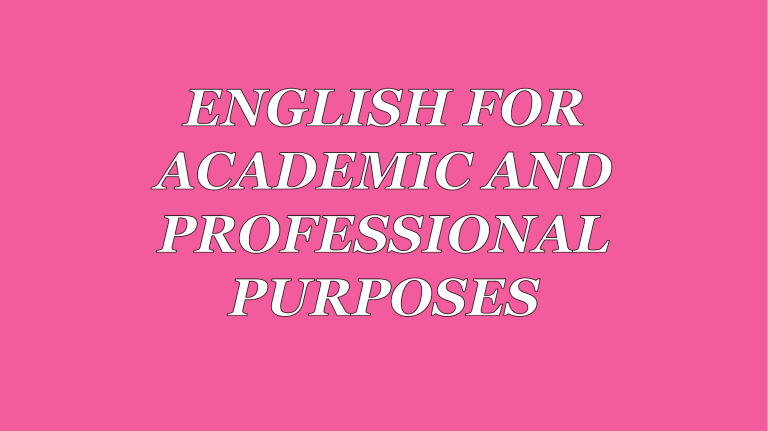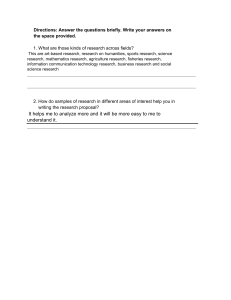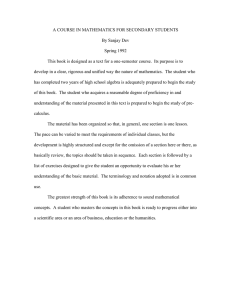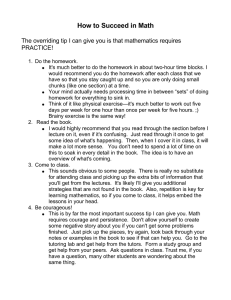
Reading Texts in Mathematics and the Humanities Presented by: Group 3 The Nature of Knowledge in Mathematics and Humanities Mathematics and Humanities seem to be polar opposite of one another. MATHEMATICS HUMANITIES • Deals with numbers and patterns. • Set of disciplines. • Accurate • Objective • Human Experiences. • Subjective The Language of Mathematics and the Humanities The registers used in the two disciplines also seems to be polar opposite of one another. MATHEMATICS HUMANITIES • Precise • Carefully and artistically phrased. • Straight to the point. • Employs a much complex register. • Only supplementary to the numbers and symbols. • Makes use of Figurative language and deviations. A Sample Textbook in Mathematics The heading “Are You Ready?” is designed to provide a quick review to the concept and an expected presentation of new lesson. The explanations that is expressed in words are brief since the language in mathematics are mainly numbers and symbols. The section “Quick Check” functions as a diagnostics test designed to asses whether you have already mastered the foundational concept needed to understand the lesson. A. REVIEW B. Lesson Opener The lesson number and title are indicated in the heading of the lesson opener. The pin-up will help you think about the significance and some concepts about the lesson. Use this to write your expectation to the lesson and revisit it after you’re done. Definition are dealt with in this portion. Pictures are used to make the lesson more interesting. A “Real-World Link” is provided to help the students see how the lesson can be used in real-life situation. READING TIP: Equations and diagrams are the interpretation of a definition in mathematics. To make sure that your computations are correct, see if they would correspond to their respective definitions. C. LESSON PROPER: Reading Tip: When dealing with mathematics, simply reading the texts and examples are not enough to fully grasps the concepts being presented. You will have to solve for the answers of the practice exercises so it will be more familiar for you. “Work Zone” is an area where you can jot down notes or write solutions. Problems to dealt with in the chapter are indicated in the headings. One sample problem from each of the concepts taught if provided to serve as an example for readers. Answering the practice problems will help you asses whether you have already understood and fully appreciated the concept taught in the chapter. C. LESSON PROPER: “Find a Rule” helps you come up with a suitable mental representation of the lesson for easier understanding. Tables are used in mathematics to represent patterns and equations. Further examples and illustrations are given to deepen the students understandings of the lesson. Reading Tip: Proficiency in math does not only entail the memorization of patterns to solve certain types of problems. It also involves being able to use foundational concepts in order to come up with a new and creative solutions to more difficult problems. D. ASSESSMENT Towards the end of the chapter, there are practice questions designed to make you more familiar with the processes involved in solving different sorts of problems. Reading Tip: When solving practice problems, do not hesitate to go back to the definitions presented earlier in the chapter to test whether your interpretation of the concepts is accurate or not. More practice problems are provided until the very end of the chapter. Notice that these are plainly numeral problems, and practical real life problems to help you apply these math problems for day-to-day situations. H.O.T Problems (Higher Order Thinking) challenges section is included to test the extent that you have mastered a mathematical concept. Unlike the previous problems, this requires you to employ you entire repertoire of thinking and mathematical skills. From this point on, another series of problem is presented until the end of the chapter. A Sample Textbook in Humanities A. Lesson Opener READING TIP: Remember that literary texts are products of their time. Thus, knowing the historical background in which they were born will enable you to correctly interpret the images and symbols found in them and develop a richer appreciation of them. A. The Lesson Number and Lesson Title are indicated in the Lesson Opener. The Focusing Question is intended to direct you to the main point being established in the lesson. A Historical Background of the period where literary texts featured in a chapter is included to help you understand them better. READING TIP: Remember that literary texts are products of their time. Thus, knowing the historical background in which they were born will enable you to correctly interpret the images and symbols found in them and develop a richer appreciation of them. Lesson Opener B. Lesson Opener: Author’s Background This section Prepare to Read provides background information on the text itself through a brief biography of the author and other pertinent elements. The Unveil What You Know section aims to connect your personal experiences with that represented in the text. The Vocabulary Building exercise is intended to unlock the meanings of unfamiliar words. The Pre-Reading Question serves to stir your interest as a reader and provide clues on the theme of the text. A Picture and Biography of the author is provided to give you an idea of why he wrote the way he did. READING TIP: Use the pre-reading question as a guide that will focus you to the important points conveyed by the text. C. Lesson Proper: The Literary Itself The picture is intended to help you visualize the contents of the text. The portion features the text’s title as well as its author. The citation of the author’s name is called a byline. This constitutes to text itself The learning objectives are the specific skills you have to master after going through the lesson. READING TIP: • Use the picture to formulate wise inferences about the selection. • Use the learning objectives to make your reading more focused. Remember that the learning objectives will also determine how you are going to be assessed by your teacher. Once more, a picture is included to help you visualize the text’s contents. This is the continuation of the text introduced in the previous page. A Tip is included to make the reading more interesting and relatable. WRITING TIP: To get more from the text you are reading, examine the rhetorical (or writing) techniques the author employed because you may want to employ them in one of your future writing endeavors to make your piece more attractive and powerful. D. Assessment This is the last installment of the text in the sample chapter. These are known as the Remembering Questions because they simply point you to specific details in the text. The questions under Understanding determines if you understood the main idea conveyed by the passage. Analyzing Questions seek to develop critical thinking. Evaluating Questions aim to unearth the values you formed as a result of reading text. A Creating Question challenges you to come up with an output as a result of what you have learned. Also known as the Post-Reading Activity.



